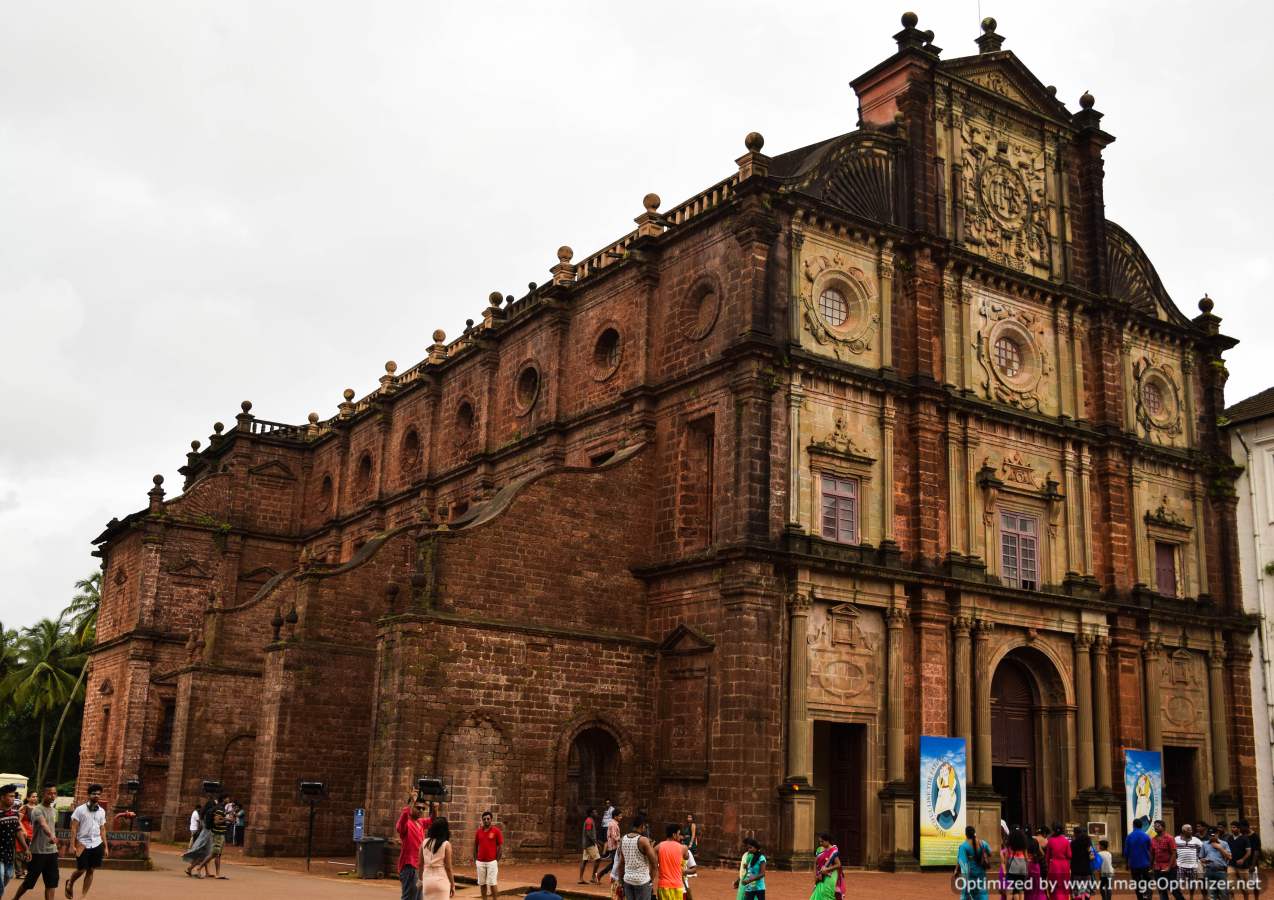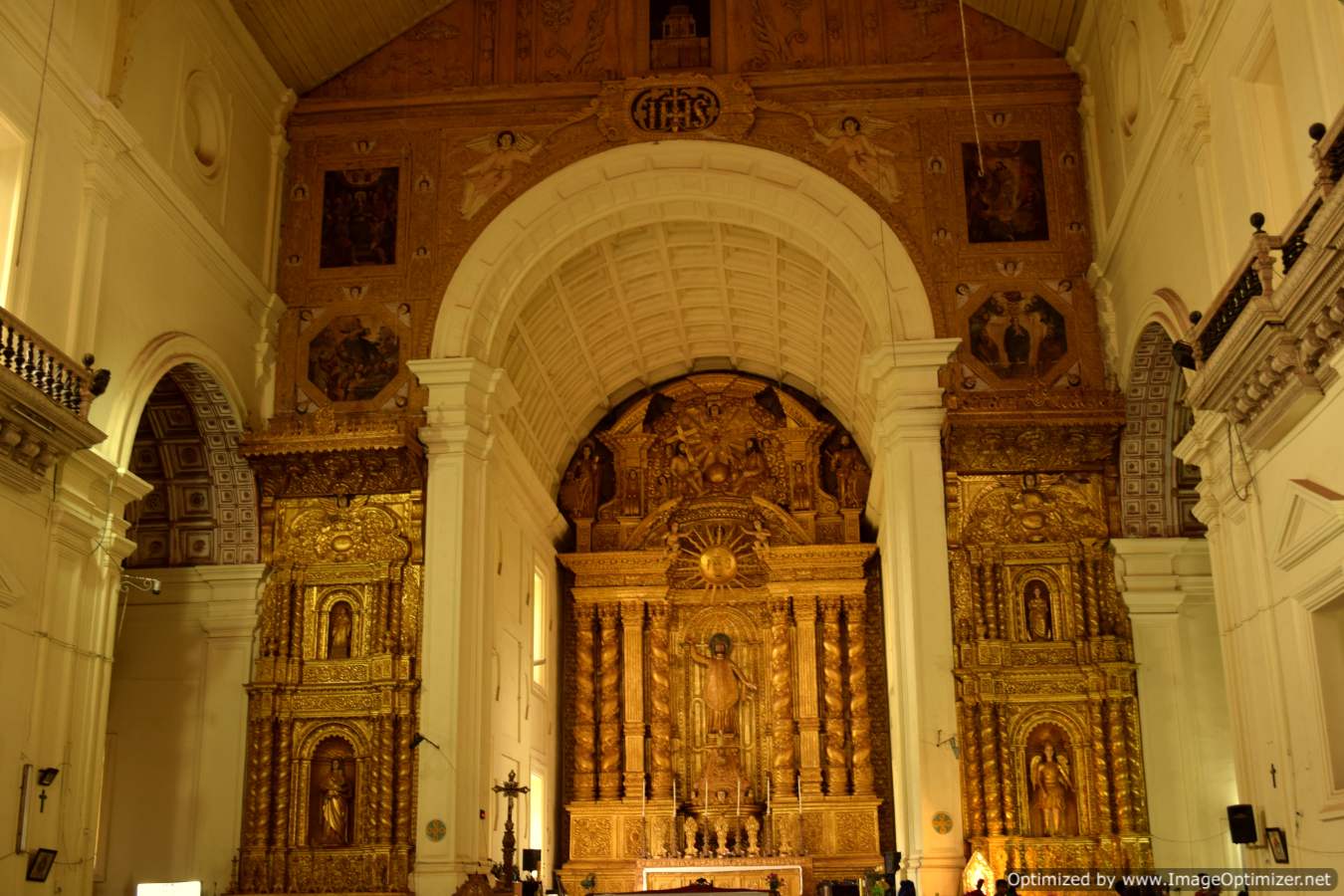The Portuguese arrived in Goa around 500 years ago and left their unique footprints. Their influence can be felt in every corner of the state, in the cuisines, architecture, heritage and lifestyle; but nowhere it is felt more than in Old Goa.
Old Goa’s effect was purely transcendental to me, my pace changing from brisk hops from one point to the other to a more languid, circuitous, absorbing stroll. It seemed my legs clamoured for a long walk in this heritage town where number of tourists at any point of the year can outnumber the number of residents. The town is so steeped in history that it is best to slow down and admire the details.

A simple combination of mud stones-straw and the seat of archdiocese of Goa, the Se Cathedral.
Once a city of 200,000 (more than the population of London at that time), Old Goa was the epicentre of all trade for the Portuguese. Over the course of a century, Goa became one of the important trade centres outside Europe. One Dutch visitor compared it with Amsterdam for its wealth; and the grand churches won it a sobriquet ‘Rome of the East’. However, its fall was just as swift as its rise, epidemic of plague and cholera led to abandonment of the old town and what remains today of this Portuguese legacy is a UNESCO World Heritage site.

Church of St Francis of Assisi
Not much of old Goa is left today but you absolutely must take a day to explore the flaking churches and crumbling colonial mansions. Along any winding back road, you will find colonial mansions and villas, painted in vivid primary colors, with bright-red tiled roofs and lacy wooden trim, hidden behind banana or coconut trees. Goa still maintains its cultural exceptionalism, a part of it explained by the fact that it became an official Indian state only in 1987; almost 40 years after greater India coalesced.

The highlight of the trail of Old Goa is the Basilica Bom Jesus, which enshrines the mortal remains of St Francis Xavier.
The highlight of the trail of Old Goa is the Basilica Bom Jesus, which enshrines the mortal remains of St Francis Xavier. Its towering facade, inlaid marble floor, ornate altars and an otherwise simple interiors, make Basilica Bom Jesus, one of the finest examples of baroque architecture in India. Marty, my guide, detailed out the finer nuances of the church, I pretended to listen, but was more lost in absorbing the astounding beauty and the detailed interiors of the church. Portuguese had lavished their pride and alacrity upon Goa – towering buildings that could shame the giants, richly gilded work, put to show probably by the greatest artists of that time and richness and warmth in designs and patterns; all spoke of the opulence Goa enjoyed in that bygone era. The church also houses the remains of St Francis Xavier, a Portuguese missionary charged with evangelising the Indies, who became Goa’s patron saint. His remains lie in one darkened corner near the altar, in a jewel studded casket. Crowds congregate to catch a glimpse of the Saint’s remains. The face is a rusty shade of orange now, greatly contorted but mysteriously there is still flesh on the body. No doubt, pilgrims flock from around the world to look at this miraculously well preserved body of St. Francis, who died more than 450 years ago. And if you think his body must have been embalmed, the church proclaims that nothing has been done to the body. So what should it be called – miracle, as pilgrims call it or just some unsolved mystery.

Chapel in the Basilica Bom Jesus
Right across the road, is Asia’s largest church, a simple combination of mud stones-straw and the seat of archdiocese of Goa, the Se Cathedral. The huge interiors are surprisingly plain, there are four chapels on either side of the nave, with the Chapel of the Blessed Sacrament, which is richly gilded and decorated, quite contrast to the otherwise plain interiors. Every ten years, remains of St. Francis are raised from its home in the Basilica and brought to Se’ and kept here for 44 days. At the back of Se’ is the Church of St Francis of Assisi, which is now an archaeological display.

Chapel in the Se’ Cathedral

St Augustine, with broken stones, nameless tombs and probably left with only an outline to speak of.
A short walk from Basilica is the holy hill, a different territory from the much crowded Basilica. It’s a leisurely walk uphill, followed by hypnotic chirps of birds and whiff of coconut oil from the mission. There is Museum of Christian Art, midway on the hill, with a rich display of art works salvaged from the old churches. As you walk further, remains of a vast, ruined bell tower come to sight. This complex dedicated to St Augustine, with broken stones, nameless tombs and probably left with only an outline to speak of, now turned into a large space for wildflowers to blossom and stray dogs to doze, was once a home to a saint; left to crumble, after the Portuguese packed their bags and moved to Panjim.
Another haunting beauty is the St Cajetan’s church (on way to River Mandovi), standing as a lofty imitation of St Peter’s Basilica in the Vatican. The dome is not as vast as the one in Rome, but it has some exquisite Islamic masonry on the front door to boast of. Standing close to it is a lonely arch propped up in the churchyard, a reminder of Adil Shah’s palace, the ruler of Belgaum, who was defeated by the Portuguese to gain control of Goa. Enroute to the river, you cross the Vasco de Gama arch, built by his grandson, Francis de Gama, the then Viceroy of Goa. Halt a minute there in respect of the great explorer, who told the world about India and brought the Portuguese to our doorstep.

St Cajetan’s church, an imitation of St Peter’s Basilica in the Vatican.

Vasco de Gama arch, built by his grandson, Francis de Gama, the then Viceroy of Goa.
Old Goa can easily be done in a day, but it remains with you forever. It has stories to fascinate you and its slow life and timeless charm binds you. The churches stand as raconteur, eager to share stories of a time when Goa was among the wealthiest cities in the world and the wood-framed row houses in saturated hues in the winding lanes, promise an experience of an organic indo-Portuguese culture.






[…] more about the places covered: Badami, Hampi, Old Goa, […]